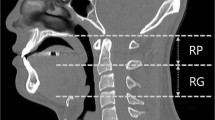Abstract
The polysomnography after nasopharyngeal tube insertion (NPT-PSG) was used to assess glossopharyngeal airway obstruction in patients with moderate-to-severe obstructive sleep apnea-hypopnea syndrome (OSAHS), and was compared with that obtained using spiral computed tomography (CT). A total of 125 patients diagnosed with moderate-to-severe OSAHS using PSG were subjected to PSG after NPT insertion, and spiral CT was used for continuous scan of the upper respiratory tract. The NPT-PSG and CT scan results were subjected to correlation analysis. In addition, the two sets of data were used separately to determine whether there was glossopharyngeal airway stenosis or obstruction, and the results were compared. Neither apnea hypopnea index (AHI) nor lowest oxygen saturation (LSaO2) obtained from the first PSG was significantly correlated with the cross-sectional area or the inner diameter of the glossopharyngeal airway. NPT-PSG AHI was significantly correlated with the cross-sectional area and anteroposterior diameter of the glossopharyngeal airway, with correlation coefficients of 0.264 and 0.185, and P values of 0.003 and 0.039, respectively. NPT-PSG AHI was not significantly correlated with the left–right diameter of the airway, and NPT-PSG LSaO2 was not significantly correlated with the cross-sectional area or the inner diameter of the glossopharyngeal airway. With NPT-PSG, 52 patients showed obvious glossopharyngeal airway stenosis while 73 patients did not, and with CT scan 41 patients showed obvious glossopharyngeal airway stenosis while 84 patients did not. The two methods reached the same diagnosis in 86 cases, with a consistency rate of 68.8 %. Spiral CT and NPT-PSG show certain degrees of consistency by assessing the presence of glossopharyngeal airway stenosis or obstruction, and there are also notable differences. Clinical assessment on glossopharyngeal airway obstruction should be based on a combination of multiple methods.
Similar content being viewed by others
References
Huang XZ, Feng YK, Wang ZZ et al (1987) Diagnosis and treatment of obstructive sleep apnea-hypopnea syndrome. Natl Med J China 67:587–589
Stradling JR, Davies RJ (2004) Sleep. 1: obstructive sleep apnoea/hypopnoea syndrome: definitions, epidemiology, and natural history. Thorax 59:73–78
Ye JY, Han DM, Zhang YJ et al (2000) The study about the characteristics of upper airway in obstructive sleep apnea syndrome. Chin J Otorhinolaryngol 35:278–281
Boudewyns AN, De Backer WA, Van de Heyning PH (2001) Pattern of upper airway obstruction during sleep before and after uvulopalatopharyngoplasty in patients with obstructive sleep apnea. Sleep Med 12:309–315
Singh A, Al-Reefy H, Hewitt R, Kotecha B (2008) Evaluation of Apnea Graph in the diagnosis of sleep-related breathing disorders. Eur Arch Otorhinolaryngol 265(12):1489–1494
Li SH, Dong S, Shi HJ, Dong WD et al (2002) Localization of upper airway stricture in patients with obstructive sleep apnea syndrome by CT scan. Chin J Otorhinolaryngol 37(2):133–136
Li SH, Qu S, Dong S, Shi HJ, Dong WD et al (2002) The CT assessment of normal adult upper airway. Chin J Clin Anat 20(6):447–450
He Y, Liu QY, Wang J, Jiang ZH (2012) MSCT evaluation for the upper airway multi-level narrowing in patients with OSAHS. Radiol Pract 27(5):509–511
Tang XL, Yi HL, Luo HP, Xiong YP, Meng LL, Guan J, Chen B, Yin SK (2012) The application of ct to localize the upper airway obstruction plane in patients with OSAHS. Otolaryngol Head Neck Surg 147(6):1148–1153
Tweedie DJ, Skilbeck CJ, Lloyd-Thomas AR, Albert DM (2007) The nasopharyngeal prong airway: an effective post-operative adjunct after adenotonsillectomy for obstructive sleep apnoea in children. Int J Pediatr Otorhinolaryngol 71(4):563–569
Huo H, Li WY, Shen P, Liu JH (2010) A preliminary observation of one-night obstructive sleep apnea-hypopnea syndrome treatment using nasopharyngeal tube. Chin J Otorhinolaryngol Head Neck Surg 45(5):382–386
Li Shu-hua Wu, Da-hai Bao Ji-min, Hong-jin Shi (2013) Outcomes of upper airway reconstructive surgery for obstructive sleep apnea syndrome based on polysomnography after nasopharyngeal tube insertion. Chin Med J 126(24):4674–4678
Li S, Wu D, Bao J, Shi H (2014) The nasopharyngeal tube: a simple and effective tool to indicate the need for uvulopalatopharyngoplasty. Laryngoscope 124(4):1023–1028
Iber C, Ancoli-Israel S, Chesson AL, Quan SF (2007) The AASM manual for the scoring of sleep and associated events: rules, terminology and technical specifications. American Academy of Sleep Medicine, Westchester
Soares D, Folbe AJ, Yoo G, Badr MS, Rowley JA, Lin HS (2012) Drug-induced sleep endoscopy vs awake Muller’s maneuver in the diagnosis of severe upper airway obstruction. Otolaryngol Head Neck Surg 148:151–156
Demin H, Jingying Y, Jun W, Qingwen Y, Yuhua L, Jiangyong W (2002) Determining the site of airway obstruction in obstructive sleep apnea with airway pressure measurements during sleep. Laryngoscope 112(11):2081–2085
Soares D, Sinawe H, Folbe AJ, Yoo G, Badr S, Rowley JA, Lin HS (2012) Lateral oropharyngeal wall and supraglottic airway collapse associated with failure in sleep apnea surgery. Laryngoscope 122(2):473–479
Li S, Wu D, Shi H (2013) Treatment of obstructive sleep apnea hypopnea syndrome caused by glossoptosis with tongue-base suspension. Eur Arch Otorhinolaryngol 270(11):2915–2920
Conflict of interest
None.
Author information
Authors and Affiliations
Corresponding author
Additional information
M. Song and J. Bao contributed equally to this work.
Rights and permissions
About this article
Cite this article
Song, M., Bao, J., Wang, X. et al. Diagnosis of glossopharyngeal obstruction using nasopharyngeal tube versus CT scan in obstructive sleep apnea-hypopnea syndrome. Eur Arch Otorhinolaryngol 272, 1175–1180 (2015). https://doi.org/10.1007/s00405-015-3520-1
Received:
Accepted:
Published:
Issue Date:
DOI: https://doi.org/10.1007/s00405-015-3520-1




